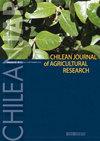利用多变量分析确定罗布斯塔和阿拉比卡咖啡无性系的亲缘关系模式
IF 1.7
4区 农林科学
Q2 Agricultural and Biological Sciences
引用次数: 2
摘要
印度尼西亚工业与饮料作物研究所(IIBCRI)对各种咖啡的亲缘关系进行鉴定对未来的咖啡育种过程至关重要。亲属关系分析可采用多变量分析。本研究旨在利用多变量分析方法对咖啡无性系的亲缘关系和特定形态特征进行鉴定。实验采用观测法进行,并用协方差分析进行校正。所用植物材料为罗布斯塔咖啡(Coffea canephora Pierre ex A. Froehner)的5个基因型和阿拉比卡咖啡(Coffea arabica L.)的3个基因型。研究的罗布斯塔菌基因型为BP 308、BP 436、BP 42、SA 237和SA 203;阿拉比卡的基因型分别为s795、Kartika 1和Kartika 2。该研究使用了IPGRI(国际植物遗传资源研究所)改良的咖啡植物描述符。形态性状共有46个。结果表明,IIBCRI的咖啡无性系在类群间和种内无性系间均具有较高的多样性。分组结果表明,罗布斯塔咖啡亚组1由BP 308、SA237和SA203咖啡无性系组成。相反,罗布斯塔咖啡的亚组2由BP 436和BP 42组成。至于阿拉比卡咖啡,第1亚组由Kartika 1和Kartika 2无性系组成,而S795无性系只属于第2亚组。基于本研究,IIBCRI也被认为适合于咖啡,特别是罗布斯塔咖啡的形态系选择和鉴定。托叶形状、叶面波的牢固度、叶边波的牢固度;花序和花的描述(15):花序位置,老木本花序,花药插入,花尖形状,花基形状,每腋花数,每腋束数,每束花数,花冠盆长,雄蕊数,花冠长度,花冠宽度,花药长度,柱头长度,雌蕊长度;涵盖的果实描述(7):果实颜色、果实形状、果盘形状、内果皮质地、果实长度、果实宽度和果肉厚度;种子描述涵盖了(7):果皮种子长度、豆长、果皮种子宽度、豆宽、果皮种子厚度、豆厚、果皮种子形状。观察使用常用的观察工具,如仪表工具、尺子、游标卡尺、笔、数字秤等进行定量特征的识别。除此之外,本研究还使用了来自英国伦敦皇家园艺学会(Royal Horticultural Society, London, UK)的颜色图表来观察颜色形态特征。本文章由计算机程序翻译,如有差异,请以英文原文为准。
Determining kinship pattern of robusta and arabica coffee clones using multivariate analysis
Identification of kinship in various coffees in the Indonesian Industrial & Beverages Crops Research Institute (IIBCRI) is essential for the coffee breeding process in the future. The kinship analysis can be done by using multivariate analysis. This study aimed to identify the kinship pattern and specific morphological characteristics of the coffee clone collections by using multivariate analysis. The experiment was carried out through the observational method corrected with analysis of covariance. The plant materials used were five genotypes of robusta coffee ( Coffea canephora Pierre ex A. Froehner) and three arabica coffee ( Coffea arabica L.) genotypes. Robusta genotypes studied were BP 308, BP 436, BP 42, SA 237, and SA 203; and arabica genotypes were S 795, Kartika 1, and Kartika 2. The study used an IPGRI (International Plant Genetic Resources Institute) list descriptor modified for coffee plants characterization. The morphological characters consisted of 46 characters. The results showed that coffee clones in the IIBCRI had relatively high diversity in clone grouping, both between types and between clones within the species. The grouping results showed that subgroup 1 of the robusta coffee consisted of BP 308, SA237, and SA203 coffee clones. Conversely, subgroups 2 of the robusta coffee consisted of BP 436 and BP 42. As for arabica coffee, subgroup 1 consisted of Kartika 1 and Kartika 2 clones, while the S795 clone has grouped solely in subgroup 2. Based on this study, the IIBCRI was also considered suitable for selecting and identifying morphological lines of coffee, particularly robusta coffee. stipule shape, firmness of leaf surface waves, and firmness of leaf edge waves; inflorescence and flower description covered (15): inflorescence position, inflorescence on old wood, anther insertion, flower tip shape, flower base shape, number of flowers per axil, number of fascicles per axil, number of flowers per fascicle, corolla tub length, number of stamens, corolla length, corolla width, anther length, stigma length, and pistil length; fruit description covered (7): fruit color, fruit shape, fruit-disc shape, endocarp texture, fruit length, fruit width, and pulp thickness; and seed description covered (7): husk seed length, bean length, husk seed width, bean width, husk seed thickness, bean thickness, and husk seed shape. The observation used the common observation tools, like meter tool, ruler, vernier calipers, pen, and digital scales to identify the quantitative characters. Besides that, the additional tool used in this study was the color chart from the Royal Horticultural Society (London, UK) to observe color morphology characters.
求助全文
通过发布文献求助,成功后即可免费获取论文全文。
去求助
来源期刊
CiteScore
3.00
自引率
11.80%
发文量
60
审稿时长
6 months
期刊介绍:
ChileanJAR publishes original Research Articles, Scientific Notes and Reviews of agriculture, multidisciplinary and agronomy: plant production, plant protection, genetic resources and biotechnology, water management, soil sciences, environment, agricultural economics, and animal production (focused in ruminant feeding). The editorial process is a double-blind peer reviewing, Editorial Office checks format, composition, and completeness, which is a requirement to continue the editorial process. Editorial Committee and Reviewers evaluate relevance and scientific merit of manuscript.

 求助内容:
求助内容: 应助结果提醒方式:
应助结果提醒方式:


